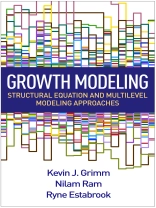Growth models are among the core methods for analyzing how and when people change. Discussing both structural equation and multilevel modeling approaches, this book leads readers step by step through applying each model to longitudinal data to answer particular research questions. It demonstrates cutting-edge ways to describe linear and nonlinear change patterns, examine within-person and between-person differences in change, study change in latent variables, identify leading and lagging indicators of change, evaluate co-occurring patterns of change across multiple variables, and more. User-friendly features include real data examples, code (for Mplus or NLMIXED in SAS, and Open Mx or nlme in R), discussion of the output, and interpretation of each model’s results. User-Friendly Features *Real, worked-through longitudinal data examples serving as illustrations in each chapter. *Script boxes that provide code for fitting the models to example data and facilitate application to the reader’s own data. *’Important Considerations’ sections offering caveats, warnings, and recommendations for the use of specific models. *Companion website supplying datasets and syntax for the book’s examples, along with additional code in SAS/R for linear mixed-effects modeling.
表中的内容
I. Introduction and Organization 1. Overview, Goals of Longitudinal Research, and Historical Developments Overview Five Rationales for Longitudinal Research Historical Development of Growth Models Modeling Frameworks and Programs 2. Practical Preliminaries: Things to Do before Fitting Growth Models Data Structures Longitudinal Plots Data Screening Longitudinal Measurement Time Metrics Change Hypotheses Incomplete Data Moving Forward II. The Linear Growth Model and Its Extensions 3. Linear Growth Models Multilevel Modeling Framework Multilevel Modeling Implementation Structural Equation Modeling Framework Structural Equation Modeling Implementation Important Considerations Moving Forward 4. Continuous Time Metrics Multilevel Modeling Framework Multilevel Modeling Implementation Structural Equation Modeling Framework Structural Equation Modeling Implementation Important Considerations Moving Forward 5. Linear Growth Models with Time-Invariant Covariates Multilevel Model Framework Multilevel Modeling Implementation Structural Equation Modeling Framework Structural Equation Modeling Implementation Important Considerations Moving Forward 6. Multiple-Group Growth Modeling Multilevel Modeling Framework Multilevel Modeling Implementation Structural Equation Modeling Framework Structural Equation Modeling Implementation Important Considerations Moving Forward 7. Growth Mixture Modeling Multilevel Modeling Framework Multilevel Modeling Implementation Structural Equation Modeling Framework Structural Equation Modeling Implementation Model Fit, Model Comparison, and Class Enumeration Important Considerations Moving Forward 8. Multivariate Growth Models and Dynamic Predictors Multilevel Modeling Framework Multilevel Modeling Implementation Structural Equation Modeling Framework Structural Equation Modeling Implementation Important Considerations Moving Forward III. Nonlinearity in Growth Modeling 9. Introduction to Nonlinearity Organization for Nonlinear Change Models Moving Forward 10. Growth Models with Nonlinearity in Time Multilevel Modeling Framework Multilevel Modeling Implementation Structural Equation Modeling Framework Structural Equation Modeling Implementation Important Considerations Moving Forward 11. Growth Models with Nonlinearity in Parameters Multilevel Modeling Framework Multilevel Modeling Implementation Structural Equation Modeling Framework Structural Equation Modeling Implementation Important Considerations Moving Forward 12. Growth Models with Nonlinearity in Random Coefficients Multilevel Modeling Framework Multilevel Modeling Implementation Structural Equation Modeling Framework Structural Equation Modeling Implementation Important Considerations Moving Forward IV. Modeling Change with Latent Entities 13. Modeling Change with Ordinal Outcomes Dichotomous Outcomes Polytomous Outcomes Illustration Multilevel Modeling Implementation Structural Equation Modeling Implementation Important Considerations Moving Forward 14. Modeling Change with Latent Variables Measured by Continuous Indicators Common-Factor Model Factorial Invariance over Time Second-Order Growth Model Illustration Structural Equation Modeling Implementation Important Considerations Moving Forward 15. Modeling Change with Latent Variables Measured by Ordinal Indicators Item Response Modeling Second-Order Growth Model Illustration Important Considerations Moving Forward V. Latent Change Scores as a Framework for Studying Change 16. Introduction to Latent Change Score Modeling General Model Specification Models of Change Illustration Structural Equation Modeling Implementation Important Considerations Moving Forward 17. Multivariate Latent Change Score Models Autoregressive Cross-Lag Model Multivariate Growth Model Multivariate Latent Change Score Model Illustration Structural Equation Modeling Implementation Important Considerations Moving Forward 18. Rate-of-Change Estimates in Nonlinear Growth Models Growth Rate Models Latent Change Score Models Illustration Multilevel Modeling Implementation Structural Equation Modeling Implementation Important Considerations Appendix A. A Brief Introduction to Multilevel Modeling Illustrative Example Multilevel Modeling and Longitudinal Data Appendix B. A Brief Introduction to Structural Equation Modeling Illustrative Example Structural Equation Modeling and Longitudinal Data References Author Index Subject Index About the Authors
关于作者
Kevin J. Grimm, Ph D, is Associate Professor in the Department of Psychology at Arizona State University, where he teaches graduate courses on quantitative methods. His research interests include longitudinal methodology, exploratory data analysis, and data integration, especially the integration of longitudinal studies. His recent research has focused on nonlinearity in growth models, growth mixture models, extensions of latent change score models, and approaches for analyzing change with limited dependent variables. Dr. Grimm organizes the American Psychological Association’s Advanced Training Institute on Structural Equation Modeling in Longitudinal Research and has lectured at the workshop for the past 12 years. Nilam Ram, Ph D, is Associate Professor in the Department of Human Development and Family Studies and the Department of Psychology at The Pennsylvania State University. He specializes in longitudinal research methodology and lifespan development, with a focus on how multivariate time-series and growth curve modeling approaches can contribute to our understanding of behavioral change. He uses a wide variety of longitudinal models to examine changes in human behavior at multiple levels and across multiple time scales. Coupling the theory and method with data collected using mobile technologies, Dr. Ram is integrating process-oriented analytical paradigms with data visualization, gaming, experience sampling, and the delivery of individualized interventions/treatment. Ryne Estabrook, Ph D, is Assistant Professor in the Department of Medical Social Sciences at Northwestern University. His research combines multivariate longitudinal methodology, open-source statistical software, and lifespan development. His methodological work pertains to developing new methods for the study of change and incorporating longitudinal and dynamic information into measurement. Dr. Estabrook is a developer of Open Mx, an open-source statistical software package for structural equation modeling and general linear algebra. He applies his methodological and statistical research to the study of lifespan development, including work on early childhood behavior and personality in late life.












